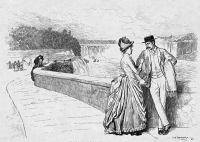SHE STARTED A HEAT WAVE BY LETTING HER SEAT WAVE.
In 1952, when Marilyn Monroe arrived at the General Brock Hotel in Niagara Falls, Ontario, she was dating Joe DiMaggio and on the brink of becoming a superstar. DiMaggio checked into the Hotel Niagara (on the American side) while, over in Canada, Monroe got to work playing sultry seductress Rose Loomis in Henry Hathaway’s new film Niagara.
Niagara’s plot runs as follows: Rose Loomis is on a Falls vacation with her husband, George, recently released from an army mental hospital. But things aren’t so great between them, what with Rose vamping around town and George flying off into rages about it. She’s up to something, and he knows it. Also staying at their hotel is another couple, Ray and Polly Cutler, a happily married pair who become slowly drawn into the Loomises’ misery. The Cutlers, we learn, are on a delayed honeymoon—presumably because the Korean War intervened. George and Rose honeymooned at Niagara a few years back, before the war, and Rose has brought George back ostensibly to cheer him up. Secretly, however, she is plotting with her hunky lover to kill poor George and throw him into the Niagara River.
Though the picture put a rather hopeless spin on marriage (not to mention the literal death of love), Niagara turned Falls honeymoon fever—one hundred years old in 1952—into an epidemic. It also vaulted Marilyn Monroe into her now-familiar position as an icon of ruthless American femininity. An inordinate amount of attention, both then and since, landed on one particular scene in the movie. Rose’s young lover is supposed to have killed her husband, and Rose has just been shown George’s unclaimed shoes at Table Rock House, where tourists don rain gear and descend to platforms at the foot of the Falls. The police clearly believe he has committed suicide. Rose knows better, but artfully plays the part of the hysterical wife.
“Why is everyone standing around—do something! Look for him! Find him!” she cries. The Cutlers are enlisted to take her home. She’s a picture of nerves as they approach the car. But then Rose hears the bell tower playing her favorite song—the signal from her lover that the murder went off without a hitch—and suddenly she stops.
“You’ve been very kind, but thanks, I’d rather walk,” she says. The baffled Cutlers watch as Rose, in a shiny black pencil skirt, shimmies toward the Falls. The camera lingers on her retreating behind for an astonishing sixteen seconds. This shot subsequently became known as “the longest walk in film history.”
“Many an actress has walked into stardom,” writes Pierre Berton in his popular history...
You have reached your article limit
Sign up for a digital subscription and continue reading all new issues, plus our entire archives, for just $1.50/month.
Already a subscriber? Sign in





